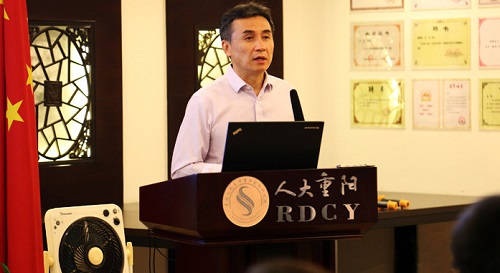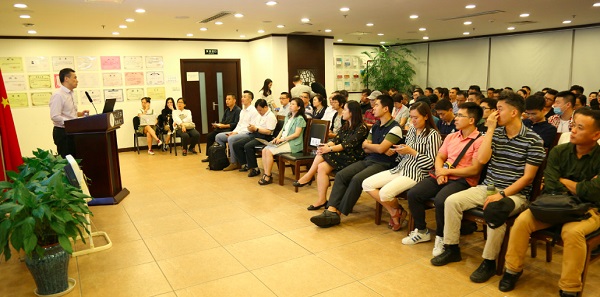Picture
Your Present Location: HOME> PictureMao Jiye: How do traditional enterprises drift to digits?
Digitalization is an important way for enterprises to transform and upgrade, which will have a subversive impact on future development. But only 7% of China's enterprises have achieved digital transformation. Why is it so difficult? How can we achieve digital transformation? On September 17, Mao Jiye, Dean of the School of Business of Renmin University of China, delivered a lecture at Chongyang Institute for Financial Studies of Renmin University of China (RDCY).

Under the background of changing, there are three major challenges for enterprises in the pace of digital transformation.
The Era of Comprehensive Interconnection. To online or offline retailers, everything happens on the mobile side. This is the era of comprehensive interconnection in which we are all experiencing but have never faced.
Today, China is in a leading position in the field of e-commerce, mobile payment, financial technology, AI applications, and share economy. Now, China is the largest market with the most active retail industry and the most cutting-edge AI technology, which is the biggest challenges to enterprises today. The golden law for enterprises is environmental awareness. Therefore, it is crucial for them whose is long-term development to develop their core competitiveness and their differentiated advantages.
Consumer group.In China, the post-80s and post-90s generation from 20 to 40 years old account for over one forth of Chinese population, which is the major consumers. It is necessary for businessmen to recognize where your consumers are and where the net-flow is. The major consumers are all attracted to buy online instead of offline consumption scene.
Over-capacity. After the subprime crisis, especially in recent years, why the development for traditional industries is so tough, but technology-based enterprises and innovative enterprises are on the contrary? In 2012 and 2013, the central government proposed "to be entrepreneur, to be innovator". Upgrading and innovation is the theme of the future, which utilizes the mobile Internet and big data to reconstruct traditional industries, new organizational structure and consumer perceptions, and change organizational boundaries. The whole process is breaking boundaries between online and offline, achieving data integration, reducing transaction costs, and reconstructing business models and profit sources.
There are four foundations of digital transformation.
The Internet of Things, IOT. Through sensors, IOT generates big data and then accumulates data on the cloud platform, and finally adopt algorithm and AI for further deep learning. Fundamentally, internal and external connectivity is achieved, which is a new era for business management. In the past, the focus was on products. Today, the speed of response is also required. The service needs to be personalized and focus more attention on output. Today, the customer-centric concept will be expressed and in practice through digital economy and digital marketing. Today, for the first time, we have the approach to perceive and insight customers, then we deploy back resources and react quickly and precisely with smart manufacturing and mass customization. And C2F and C2M will be helpful for us to observe consumer perceptions and learn consumer preferences.
Digital economy. The allocation of computer applications has transformed into a brand-new digital economy era, from point to a model comprised by point, surface, and stereo. Now, AR/VR technology can perform a variety of functions and roles as smart terminal, such as VR games, intelligent banking lobby clients and driving simulators. The transformation of financial services has also quietly carried out with APP services and provided various free services to enrich and facilitate people's lives.
Industrial restructuring. The business opportunity will appear with the booming of data era. The most typical example is the mobile livelihood service platform in Guangdong Province.
Technical architecture,including applications of big data and digital transformation. Digital transformation has been an irreversible trend in all industries. But to manufacturing industry, reconstruct the whole process by data is a big challenge. The whole process is manipulating massive data and making decisions with algorithms. Decisions will be made by AI instead of experience judgment to make sure that the whole process has been continuously improved in R&D.
How about product planning? Today, market research, topic interviews and competitive product analysis are all data-driven. In essence, big data is multi-dimensional, heterogeneous, and massive. In the future, the importance of subjective judgment and experience is constantly decreasing. We use capital to replace white-collar workers and use internal and external big data to achieve real-time access throughout the industry.
Product development, marketing and user insight are data-centric and customer-centric. For example, real-time monitoring of customer responses, collecting customer consumption behavior data, improving stores, and improving customer experience. In internal management, data are used for products, R&D, production, channels, consumers, and after-sales to achieve data-driven decision-making, combining internal and external big data.
Digital transformation is essential to satisfy consumers and meet individual needs by digitizing and intelligent algorithms. Traditional enterprises can use e-commerce to extend their services, use data to maintain hardware products and Internet software services to form a new business model. The basic characteristics of digital transformation are using data to support and drive all decisions, using big data to insight into customers, getting accurate user portraits, and achieving personalized service.
The digital transformation is difficult because it is organizational change and the deep water of reform. It requires a new organizational vision to restructure an industry. From internal transparency, visualization to intelligence, the digitization is from step-by-step connecting internal and external to generate value.
























































































 京公网安备 11010802037854号
京公网安备 11010802037854号





